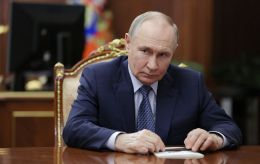Advance to the south: When will the Ukrainian Armed Forces break through Russian defense? U.S. assessment and expert opinions
 The USA gives high chances that the Armed Forces of Ukraine will reach the Sea of Azov by the end of the year (Photo: Getty Images)
The USA gives high chances that the Armed Forces of Ukraine will reach the Sea of Azov by the end of the year (Photo: Getty Images)
The U.S. Defense Intelligence Agency (DIA) has assessed Ukraine's chances of breaking through Russian defense lines. According to their assessment, the likelihood of achieving this by the end of 2023 is estimated at 40 to 50%.
More details on the Pentagon's assessment with comments from our military experts - in RBC-Ukraine material.
Three months in, the Ukrainian counteroffensive gains momentum. Ukrainian forces have breached the first line of Russian defense near the village of Robotyne (the Zaporizhzhia region) and are advancing toward the second.
"Had we had this conversation two weeks ago, I would have been slightly more pessimistic. Their (Ukrainian - Ed.) breakthrough on that second defensive belt…is actually pretty considerable," says Trent Maul, the director of analysis for America’s Defence Intelligence Agency (DIA), in an interview with The Economist.
The U.S. Defense Intelligence Agency (not to be confused with the more well-known CIA) focuses on military responses to actions by America's adversaries. This often involves quantitative assessments, such as the range of Iranian missiles or the size of the Chinese fleet.
However, after Afghanistan 2021, the agency is increasingly assigning greater importance to intangible factors. Washington miscalculated by relying on the ability of the Afghan army to resist the Taliban, which "folded pretty quickly."
This miscalculation has affected the underestimation of Ukraine in the early stages of the invasion. Currently, in a 40-page official document from DIA, Ukraine's resolve to fight against Russia has been reassessed.
Ukraine is not Afghanistan
The DIA states that President Volodymyr Zelenskyy has remained in the country, influencing the battlefield. Unlike the decision of Afghan President Ashraf Ghani to flee Kabul under Taliban pressure.
As The Economist notes, this underscores the importance of political leadership for the military and sustained support. Before the Russian invasion, the U.S. underestimated this factor, assuming that the Ukrainian government would be toppled. Now, analysts are filling in a detailed worksheet with assessments and carefully considering these aspects.
 Photo: President Volodymyr Zelenskyy and Ukraine's military-political leadership declined evacuation at the beginning of the full-scale invasion (president.gov.ua).
Photo: President Volodymyr Zelenskyy and Ukraine's military-political leadership declined evacuation at the beginning of the full-scale invasion (president.gov.ua).
The fact that the country's leadership remained in Kyiv preserved the hierarchy of power and state governance bodies. Western partners believed in us, and work began on supplying arms, says Olexander Musiienko, the head of the Center for Military-Legal Research.
Military expert Vladyslav Seleznov calls centralized military command a key factor.
"It gave confidence to the troops on the ground that everyone is working towards a common goal - victory. The West also supported us with tens and tens of billions. Former Defense Minister Oleksii Reznikov said that one day of our war costed 100 million dollars," he noted in a comment to RBC-Ukraine.
History does not have a conditional way, but it's unlikely that Ukraine would have surrendered without a decision-making center in Kyiv. If we draw historical parallels, the resistance would likely have continued, perhaps as a partisan movement against the Soviets, as it did in western Ukraine until the mid-1950s.
"But undoubtedly, the legitimacy of power and uninterrupted governance created conditions that allowed the realization of the full spectrum of combat tasks," the expert added.
The defense of the Russians in the south may have been underestimated
The new methodology of U.S. intelligence is crucial when it comes to the Ukrainian counteroffensive. According to Trent Maul, the Russians are transporting artillery shells to their positions, and it is possible that officials may have underestimated the depth of their defense lines.
In one interview, the commander of the operational-strategic group of forces Tavria, Oleksandr Tarnavskyi, provided the following figures. According to him, the occupiers allocated 60% of resources to fortify the first line and 20% each for the second and third lines. After the Ukrainian breakthrough, the enemy is forced to maneuver, and sooner or later, their forces will be exhausted, allowing the Ukrainian Armed Forces to advance more rapidly, according to the general.
However, the Director of Analysis at DIA warns that the main Russian reserves are precisely on the third line.
"They are indeed on the third line, although it should be understood that complex tasks are being carried out there. In addition to those on the third line, who cover the rear, they provide support to units on the second line in case of need," comments Oleksandr Musiienko.
Vladyslav Seleznov believes that Western partners are insincere when they emphasize the capabilities of the Russian army but do not mention who created these capabilities.
"Let's be honest to the end. It was the delay in supplying weapons and equipment to our troops that gave the Russians time to build a network of defensive structures in the south of the Zaporizhzhia region," he stated in an interview.
 Photo: Assessing the real condition of the Russian defense lines to the south of Robotyne is very difficult (deepstatemap.live)
Photo: Assessing the real condition of the Russian defense lines to the south of Robotyne is very difficult (deepstatemap.live)
According to him, it's challenging to assess the actual state of the second line to the south of Robotyne. This is partly because they have not been able to expand the bridgehead westward towards the village of Kopani, and the main movement is going further south towards Novoprokopivka and southeast towards Verbove.
"We will see what the second defense line looks like when the advance units reach the Russian positions," Seleznov noted, adding that the advance would by no means be easy, and evaluating the third line would also have to be done in practice.
The Ukrainian Defense Forces will be opposed by the 76th Guards Air Assault Division, 7th Air Assault Division, and units mobilized based on the Ryazan Airborne School.
Culmination in the coming weeks
The Economist cites a representative of the Joe Biden administration who speaks of 6-7 weeks for Ukraine before its advance reaches its climax. This is primarily due to the fall rainy season.
There is also the opinion that since large forces were thrown into the breakthrough of the first line, it is unlikely that the Ukrainian Armed Forces will be able to advance far to the south. Exhaustion of Ukrainian and Russian forces may lead to the current lines on the battlefield maps being held for a long time.
However, for such forecasts, at a minimum, one needs to know what resources the General Staff has and whether it is capable of deploying them in the Robotyne area or other areas.
"We do not have basic information about the combat capabilities of the Defense Forces, so we need to be cautious in our assessments. Do we have enough ammunition to sustain the pace of artillery fire here and now? I can only say that our pace is up to 8,000 rounds per day. And this is more than a year ago when we had a maximum of 6,000, while the enemy used up to 60,000," Seleznov noted in an interview with RBC-Ukraine.
 Photo: Experts refrain from assessing the combat capabilities of Ukraine's Defense Forces and making predictions (Getty Images)
Photo: Experts refrain from assessing the combat capabilities of Ukraine's Defense Forces and making predictions (Getty Images)
According to him, in 5-6 weeks (approximately after October 15), the weather will become rainy to the extent that vehicles will get stuck in the fields. This applies not only to the south but also to the eastern front.
It's not appropriate to outline the course of military operations week by week because the counteroffensive is ongoing. Regardless of where the front line will be by the end of the year, the Ukrainian Armed Forces are doing the work they can under current conditions, emphasizes expert Oleksandr Musiienko.
Possibility of a breakthrough 40-50%
This assessment is provided by Trent Maul, Director of Analysis at DIA. In his opinion, Ukraine's recent progress is significant and offers a real opportunity for further success.
Especially when considering that Russian General Sergei Surovikin, who built the defense lines, and the leader of the PMC Wagner Yevgeny Prigozhin, whose mercenaries achieved tangible territorial gains, are no longer in the game. Recall that the first fell out of favor after the "Wagnerites" mutiny, and the second likely died in a plane crash.
"Ukraine’s recent successes are 'significant' and give its forces a 'realistic possibility'—intel-speak for 40-50% probability—of breaking the remaining Russian lines by the end of the year," Maul said, but cautioned that limited ammunition supplies and worsening weather will make this an extremely challenging task.
 Photo: The Pentagon gives Ukraine up to a 50% chance of reaching the Sea of Azov by the end of the year (Getty Images)
Photo: The Pentagon gives Ukraine up to a 50% chance of reaching the Sea of Azov by the end of the year (Getty Images)
As Musiienko explains, Surovikin has always been a hawk and demonstrated efficiency in building defensive positions, lines, and conducting defense. His removal from military processes is a benefit for Ukraine. Regarding the chances of a breakthrough, 50% is a normal estimate in line with the work of the American intelligence community.
"With their gradation, 50% is not a small percentage, but rather on the higher side, close to high. For them, an estimate of 70% means a very high probability. So I would recommend treating 50% as a high chance that Ukrainian forces will indeed break through all defense lines by the end of the year," he said in a comment to RBC-Ukraine.
Intelligence is preparing the White House for further support to Ukraine
DIA analysts are already anticipating the next combat season. According to one of the scenarios, even without any significant breakthroughs, the United States expects Ukraine to expand its foothold near Robotyne, hold its positions, and ensure the supply of ammunition. In this case, Ukraine will have a good starting position for a leap in 2024.
According to Musiienko, this indicates that Ukraine's largest ally believes in it.
"If American intelligence makes such forecasts, they are included in reports for the Biden administration and the Pentagon. Based on these reports, a vision for the winter and spring is formed, a vision of how to support Ukraine in terms of the necessary forces and means," he explains.
At the same time, it is unwise to count on the inaction of the enemy. Ukrainian forces have only breached the first line, and occupiers have already brought in significant reserves.
Vladyslav Seleznov does not rule out that in the coming days, the Russians may launch a counterattack near Robotyne.
"Because airborne forces are always about an offensive. They can be used to push our assault units in the opposite direction. Also, there is the redeployment of the 25th Army from Russian territory to the east. It is not excluded that their offensive will begin immediately in several sections. Perhaps near Kupiansk-Lyman. Maybe they will try to take advantage of numerical superiority near Bakhmut or launch a counteroffensive on Robotyne," the expert warns.

